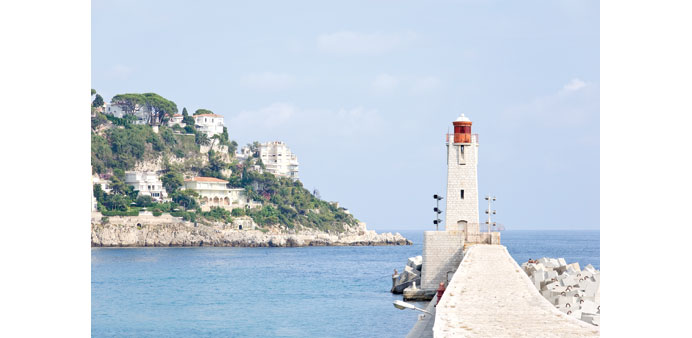A file photo of the lighthouse of Nice, on the French Riviera. As the storm raged, the main motorway in the area had to be closed, trains were brought to a standstill and hundreds of tourists took shelter at the airport in Nice. Almost 27,000 people lost electricity. Photo by Myrabella/Wikipedia
By Steff Gaulter
At least a dozen people have been killed after torrential rain poured down on the French Riviera. The sudden downpours caused a number of rivers to burst their banks, sending torrents of water rushing through towns and villages in this beautiful coastal region of southeast France.
It was the speed of the flooding that took everyone by surprise— the water increased from a trickle to hurtling rapids in just a few seconds. Some of those who died were residents of a retirement home, others drowned after their cars became stranded in a tunnel. One lady was killed on the street in Cannes, as the flood water cascaded through the town.
As the storm raged, the main motorway in the area had to be closed, trains were brought to a standstill and hundreds of tourists took shelter at the airport in Nice. Almost 27,000 people lost electricity.
In the Cannes region, it was reported that 170 mm (6.69 inches) of rain fell in just two hours. This is the same amount that the region would usually expect over two months. Meanwhile the neighbouring city of Nice received almost 10% of its average yearly rainfall in two days alone. This huge amount of rain falling in such a short amount of time explains the ferocity of the floods.
The deluge was certainly a shock for the residents. Although October is usually the wettest month of the year in southeast France, floods are not common, and the system responsible for these floods is just as unusual as the floods themselves. The severe weather was triggered by a Mediterranean hurricane, otherwise known as a “medicane”.
Typically hurricanes don’t form in the Mediterranean. These ferocious types of storms are usually reserved for the Atlantic, Pacific or Indian Oceans. Hurricanes are known as typhoons in the Philippines and Japan, and cyclones in India and Oman, but they are exactly the same type of weather system. The Mediterranean, however, may be battered by severe storms, but they are not usually classed as hurricanes.
Hurricanes are very specific types of weather systems. For one to develop, the seas need to be very warm, as the sea is their energy source. If the ocean is warm enough, then plenty of water will evaporate from the surface into the warm air just above it. This warm air will rise and as it does so it will cool. Cool air can’t hold as much water as hot air, so the moisture will condense into clouds. You may remember your physics teacher talking about latent heat at school, and this is what is released here as the water condenses. This extra heat warms up the surrounding air making it rise even higher.
Whilst all this is happening up in the clouds, at sea-level the air has to rush in to take the place of the rising air, and this is the wind that develops in these storms. The more air that rises, the quicker the air rushes in, and the more destructive the wind becomes.
To set off this chain of events, the ocean’s surface temperature has to be above 26C (79F), but in the Mediterranean the storms are slightly different. ‘Medicanes’ have been known to develop even when the sea is significantly cooler. This has prompted some meteorologists to question whether the storms really are hurricanes.
Hurricanes that try to develop in the Mediterranean are also limited by space. If you compared the size of the Mediterranean to the Atlantic or the Pacific Ocean, then clearly it is tiny. It also has a large number of islands and peninsulas jutting into it. This means that it is difficult for a storm to spend a significant time over water, as would be necessary for a powerful hurricane to develop.
However, despite this, occasionally hurricane-type systems have been spotted in the Mediterranean. They usually originate from other ‘regular’ storms, which then begin to feed off the warm waters of the Mediterranean and begin to take on the characteristics of a hurricane. Often they don’t have all the characteristics of a hurricane, so usually these storms don’t fit the perfect definition.
Due to the limitations of space in the Mediterranean, any hurricane that does manage to develop is typically small with a short life span. The weather system which hit southeast France near the beginning of this month appeared to be transforming into a hurricane on Thursday, before it started to move across the mountainous islands of Corsica and Sardinia. The high mountains disrupted the system, which fortunately prevented it from strengthening further.
After interacting with Corsica and Sardinia, the system then moved northwards, onto the south coast of France. Here, the rain was torrential and fell on steep ground, which channelled the flood water into raging torrents, creating flash floods.
Fortunately for those who live near the Mediterranean, hurricanes are still a very rare event. However, when they hit, they are often deadly. The last time that a hurricane hit the Mediterranean was on November 18, 2013. This time it was the island of Sardinia which felt the full brunt of the storm when a years’ worth of rain fell on the island in just ninety minutes. Sadly, eighteen people were killed and hundreds were made homeless.
One thing is for sure, whether these system fit the true definition of hurricanes or not, they can certainly cause significant damage. For the residents, what they are called isn’t important. Accurate warnings and preventative measures are the key to survival.

